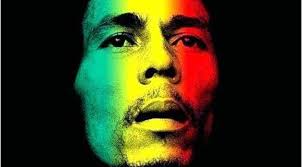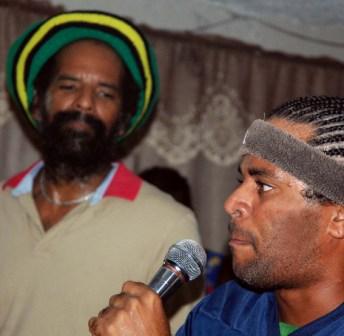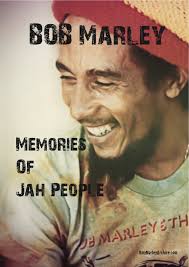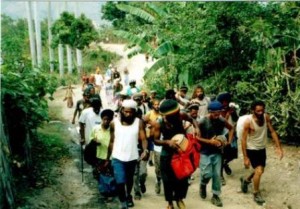 BOB MARLEY AND A BRIEF HISTORY OF THE RASTAFARIANISM IN CUBA.
BOB MARLEY AND A BRIEF HISTORY OF THE RASTAFARIANISM IN CUBA.
The Rastafarians are accompanied by a strong belief in a God, Jah (Jahveh), in Marcus Garvey as a prophet, and in the rich black Messiah (El Salvador), way to the Promised Land (Africa): Haile Selassie, Ethiopian Emperor, deceased in 1975.
For many in Cuba “El Rastafari” is the one who is connected to Reggae. He wears red, yellow and green colors in his clothing, uses dreadlocks and is a consumer of Marijuana.
The rastas studied consider racial discrimination as a manifest phenomenon in Cuban society, sustained by the constant reproduction of prejudices and racial stereotypes against the Negro.
Smoking Ganjah, Cannabis or Marijuana is a way of being closer to your God, a sacrament, but smoking is not mandatory to achieve it.
However, the “unconscious” consumption of some of its symbols in garments, earrings, necklaces and scarves, such as the union of black, red and yellow, the colors that identify it, are common among the Cuban population. .
The importance of music for the Rastas is fundamental.
THEY ARRIVE TO CUBA.
It is difficult to establish criteria with regard to the entry of the ideas of the Rastafari movement in Cuba before 1959. Although it is known the entry to Cuba since 1913 of thousands of Antillean immigrants, especially Jamaicans and Haitians, it is important to underline that this migratory flow it stopped abruptly, without recovering, in the first years of the decade of the ’30 – mainly because of the world economic crisis that also had its influence on Cuba -. Fact that coincidentally coincides with the emergence of the Rastafari. So it becomes very difficult to search for the entry of their ideas in those years, at least from the point of view of migration.
The Rastafari’s ideas only extended to Cuba during the 1990s.
The Rastafari cultural and religious system came to Cuban lands since the 70s of the last century, did not reach a boom until 1991 when the ruling Communist Party of Cuba accepted people of any creed or religion in its ranks, it was unthinkable in its beginnings, because he was valued as a foreigner and divergent with the Cuban revolutionary process. It was really difficult for society in general and the institutional authorities to accept overnight a culture based on religion, linked to the person of the then “black God” Haile Selassie I; that idealized the African continent, “he explained.
Rastafari offered to those who approached him from music and religion fundamentally, the possibility of positions of racial reaffirmation, black pride, subversion of Eurocentric beauty patterns and criticism of white hegemony, among others.
BOB MARLEY.
In the young population, especially among black males and mestizos of the popular strata of Cuban society, this culture was most prevalent, emerged in Jamaica and promoted internationally by reggae singer Bob Marley, who is today one of the symbols of This group, also classified by some specialists as one of the many urban tribes.
Rastas people, as they are popularly known, have also been associated in Cuba with criminality, prostitution and marginality. However, the “unconscious” consumption of some of its symbols in garments, earrings, necklaces and scarves, such as the union of black, red and yellow, the colors that identify it, are common among the Cuban population. .
Although in Cuba insisting on the construction of a legal system that endorses and defends racial equality, the Cuban state has not done enough to eliminate a phenomenon that is present in Cuban social consciousness as a historical heritage and that has been reproduced on a daily basis.
For many Reggae is considered the main attraction that calls people to enter the ideas of Rastafari. For them, through reggae movement has been known in the world, because it is seductive even for those who are not part of it. The relevance of music does not only lie in the rhythm and its melody loaded with African and Caribbean influences, but mainly in the messages it transmits as an identifier of the ideas and principles of the Rastafari.
According to some people, reggae expresses strong messages in their songs. Account “the history of the blacks by the own blacks”, next to anecdotes of Africa, of Selassie; It is a means to denounce what is wrong and bring harmony, peace and tranquility.
That is why the rise of Rastafari in Cuba could be considered as part of religious revival occurred in the early 90s, and may have functioned as shelter and means of protest of certain individuals to the situation of hostility that surrounded the social reality .
 BOB MARLEY Y UNA BREVE HISTORIA DEL RASTAFARISMO EN CUBA.
BOB MARLEY Y UNA BREVE HISTORIA DEL RASTAFARISMO EN CUBA.
Los Rastafaris los acompaña una fuerte creencia en un Dios, Jah (Jahveh), en Marcus Garvey como profeta, y en el Mesías negro y rico (el Salvador), camino hacia la Tierra Prometida (África): Haile Selassie, Emperador Etíope, fallecido en 1975.
Para muchos en Cuba “El Rastafari” es quien está conectado con el Reggae. Lleva colores rojos, amarillos y verdes en su indumentaria, usa dreadlocks y es un consumidor de Marihuana.
Los rastas estudiados consideran la discriminación racial como un fenómeno manifiesto en la sociedad cubana, sustentado por la constante reproducción de los prejuicios y estereotipos raciales contra el negro.
Fumar Ganjah, Cannabis o Marihuana es una vía de estar más cerca de su Dios, un sacramento, pero no es obligatorio fumar para lograrlo.
Sin embargo, resultan comunes entre la población cubana el consumo “inconsciente” de algunos de sus símbolos en prendas de vestir, aretes, collares y bufandas, como por ejemplo, la unión del negro, el rojo y el amarillo, los colores que la identifican.
La importancia de la música para los rastas es fundamental.
LLEGAN A CUBA.
Es difícil establecer criterios con respecto a la entrada de las ideas del movimiento Rastafari en Cuba antes de 1959. Aunque es conocido el ingreso a Cuba desde 1913 de miles de inmigrantes antillanos, sobre todo jamaicanos y haitianos, es importante subrayar que este flujo migratorio se detuvo bruscamente, sin recuperarse, en los primeros años de la década del ’30 – principalmente a causa de la crisis económica mundial que también tuvo su influencia sobre Cuba -. Hecho que casualmente coincide con el surgimiento del Rastafari. De modo que se torna muy difícil la búsqueda de la entrada de sus ideas en esos años, por lo menos desde el punto de vista de las migraciones.
Las ideas del Rastafari sólo llegaron a extenderse en Cuba durante la década de 1990.
El sistema cultural y religioso Rastafari llegó a tierras cubanas desde los años 70 del pasado siglo XX, no alcanzó auge hasta 1991 cuando el gobernante Partido Comunista de Cuba aceptó en sus filas a personas de cualquier credo o religión, era impensable en sus inicios, porque se le valoraba como extranjerizante y divergente con el proceso revolucionario cubano. Era realmente difícil que la sociedad en general y las autoridades institucionales aceptaran de la noche a la mañana una cultura de base religiosa, ligada a la persona del entonces “Dios negro” Haile Selassie I; que idealizaba al continente africano”, detalló.
Rastafari ofreció a quienes se le acercaron desde la música y la religión fundamentalmente, la posibilidad de posiciones de reafirmación racial, orgullo negro, de subversión de los patrones eurocéntricos de belleza y la crítica a la hegemonía blanca, entre otras.
En la población joven, sobre todo entre varones negros y mestizos de las capas populares de la sociedad cubana, fue donde más caló esta cultura, surgida en Jamaica y promovida internacionalmente por el cantante de reggae Bob Marley, quien es hoy uno de los símbolos de este grupo, también clasificado por algunos especialistas como una de las tantas tribus urbanas.
Las personas rastas, como se les conoce popularmente, también han sido asociadas en Cuba con la criminalidad, la prostitución y la marginalidad. Sin embargo, resultan comunes entre la población cubana el consumo “inconsciente” de algunos de sus símbolos en prendas de vestir, aretes, collares y bufandas, como por ejemplo, la unión del negro, el rojo y el amarillo, los colores que la identifican.
Aunque en Cuba insistiendo en la construcción de un sistema legal que avalara y defendiera la igualdad racial el estado cubano no ha hecho lo suficiente para eliminar un fenómeno que se encuentra presente en la conciencia social cubana como herencia histórica y que se ha logrado reproducir cotidianamente.
Para muchos el Reggae es considerado como el principal atractivo que llama a la gente a entrar en las ideas del Rastafari. Para ellos, a través del reggae se ha conocido al movimiento en el mundo, pues resulta seductora incluso para quienes no son parte de él. La relevancia de la música no recae solamente en el ritmo y su melodía cargada de influencias africanas y caribeñas, sino principalmente en los mensajes que transmite como identificadora de las ideas y los principios del Rastafari.
Según manifiestan algunos el reggae expresa fuertes mensajes en sus canciones. Cuenta “la historia de los negros por los propios negros”, junto a anécdotas de África, de Selassie; es un medio para denunciar lo mal hecho y traer armonía, paz y tranquilidad.
RITA MARLEY (born in Santiago de Cuba)
Bob Marley widow.
Es por ello que el auge del Rastafari en Cuba podría ser considerado como parte del reavivamiento religioso ocurrido en la década de los ’90, y puede haber funcionado como refugio y medio de protesta de determinados individuos ante la situación de hostilidad que envolvía la realidad social.
Agencies / Various / Wiki / Regina Cano/ Internet Photos / YouTube / Arnold Varona/ www.thecubanhistory.com
THE CUBAN HISTORY, HOLLYWOOD.







